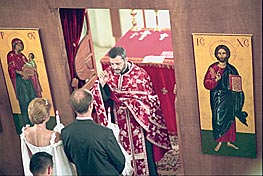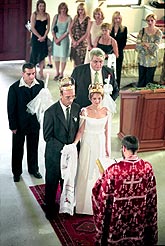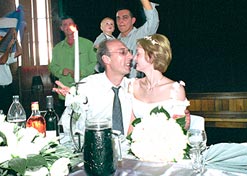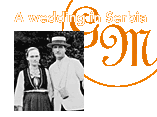
|
| The couple's betrothal |
Dragana & Jadranko
Author: Megan Wynne-Jones, Getting Married project
Getting Married: Jadranko and his witness are waiting nervously in the porch of St Stephen's Serbian Orthodox church at Rooty Hill in Sydney's western suburbs, while the wedding guests gather outside. They take sips from an ibrik, a richly ornamented bottle of sljivovica, a plum brandy that is traditional to Serbia.
An interpreter was used for this story.
A traditional Serbian Orthodox wedding
The bride arrives
With a fanfare of car horns, the bridal party arrives. Two large flags, one
Australian, one Serbian, are waved from the window of the first car as the convoy
pulls up in front of the church. Dragana, in a long white dress, steps out of
a stretch limousine, accompanied by two men. One is holding the Serbian flag:
red, blue and white stripes emblazoned with a double headed, crowned white eagle
bearing a crest. Her other companion, traditionally the dever or groom's
brother, is wearing a white sash across his body. Photographs are taken of Dragana
and her companions, who will stay with her for the duration of the wedding ceremony.
They move towards the church, to join Jadranko and the witnesses.
Into the church
The bride and groom enter first, followed by two witnesses, one known as the
stari svat, and the other the kum or godparent, who plays
an important role throughout a person's life, and especially at their
wedding. These two are followed by the dever and the flag-bearer, the
barjaktar who now has a towel and shirt attached to his flagpole, gifts
from the bride. As the church bells ring the guests follow the couple inside,
lighting candles at the entrance and stooping to kiss the images of Christ and
the Madonna, freshly adorned with sprigs of basil.
A simple setting
The interior of the church is simple, with a concrete floor adorned with a long
strip of red carpet, and without seating. The guests gather inside in mixed
groups. Traditionally at a Serbian Orthodox wedding men and women would gather
in separate groups on either side of the church. The most elaborate ornamentation
is the octagonal shaped maroon table in the centre, on which sit the objects
that will be used during the wedding.
Towards the Royal Doors

Binding their hands
Each carrying a candle decorated with white cloth, the couple progress to the
front of the church toward the Iconostasis, the holy screen covered
with icons, and stand before the Royal Doors of the altar, so called as originally
only anointed royalty would be allowed there. Here they are greeted by the priest,
Father Srbo, who is dressed in a richly embroidered maroon robe, and carries
a kadionica or incense burner. Father Srbo formally greets the couple
and invites them to prayer.
The betrothal
The ‘betrothal', which takes place at the Royal Doors, begins the
long marriage ceremony which is conducted in song by the priest. Father Srbo
sings prayers from the Bible, which tell of marriages and God's blessings.
The gold rings, which have been blessed, are lying on the nearby altar table.
Father Srbo places the bride's ring half-way down Jadranko's ring
finger, removes it, and then places the groom's ring half-way down Dragana's
finger and removes it. The kum then steps forward and does a similar
exchange three times, finally leaving the rings on. Father Srbo explained that
“The number three is used often in Serbian traditions, and here it symbolises
the Holy Trinity of Father, Son and Holy Ghost.”
The binding with cloth
The priest then leads the couple with their two witnesses to the centre of the
church. After a short blessing the couple hold hands, traditionally for the
first time, and a white binding cloth or peshkir is wound around their hands
by Father Srbo. The cloth symbolises that they are now bound for life.
 |
 |
|
(Dragana) In the Serbian tradition, I did the
embroidery on this, with the words Sretno Vencanje which means Happy Wedding,
and with our nicknames and with the date of our wedding.
|
Vencanje - the wedding, literally the putting on of wreaths
Jadranko and Dragana have chosen to wear gold-coloured metal crowns for this
part of their ceremony, but often wreaths made of flowers would be used, which,
according to Father Srbo, emulate the traditional Roman laurel wreath. The priest
blesses them with a cross in his hands, the couple each kiss their crowns and
he then crowns them three times. This is known as the Office of the Crowning
which sets them apart as king and queen of their new home.
The common cup
The Epistle of Paul to the Ephesians is read, which summarises the duties of
husband and wife. This is followed by the story of Jesus turning water into
wine at the wedding in Cana. In remembrance of this first miracle of Christ
the couple then drink three sips of wine from a common cup symbolising their
shared life together. According to Father Srbo, the drinking of wine originates
from a time when weddings were part of the Liturgy (the Eucharist or sacrament
of the Last Supper) during which the bride and groom would take communion. The
Lord's Prayer is then read by the priest.
The procession – three times around the altar
Led by the priest and accompanied by their witnesses, Jadranko and Dragana,
now husband and wife, still with their hands tied, walk around the altar three
times in honour of the Holy Trinity, symbolising eternity and the couple's
pledge to preserve their marriage bond until death. During this procession a
hymn is sung to the Holy Martyrs, reminding the couple of the sacrificial love
they will share in marriage.
The wedding service concludes
Father Srbo then removes their crowns, blesses them again, reads a dismissal
prayer and unties their hands. They exchange kisses with each other, and their
two witnesses. The wedding guests file past the couple, kissing them and offering
them congratulations on their marriage.
Outside the church, the married couple are greeted with music from an accordionist
and a singer. The kum throws money to the crowd, eagerly collected
by the children. A group of six women performs a lively traditional dance for
the couple and their guests. The party is about to begin.
Getting together
From the beginning…
Jadranko is originally from Bosnia. In 1995 he fled because of the war, lived
in Serbia for a while and then obtained permanent residency in Australia as
a refugee. He has been living in Sydney's southwestern suburb of Fairfield
ever since. In 2002, however, he returned to Serbia for a visit to see family
and friends, and attended the wedding of Dragana's brother. It was there
that the couple first met.

At the reception
The first wedding
 |
 |
|
It happened quickly. After we'd met at the wedding,
we went out together once and then spent ten days together on holiday
at the beach. It was only a month after we first met that we decided to
get married.
|
The couple had a civil wedding in a registry office in Dragana's home
town of Gornji Milonovac. This wedding was a small and simple one, attended
only by Dragana's best friend and by Jadranko's kum and
his brother. They had a small party afterwards in a restaurant and then five
days later Jadranko returned to Australia.
Dragana stayed in Serbia and applied for a visa to come to Australia. Her parents,
who now live in Germany, knew nothing of her marriage or her migration plans
until she called them when she came to Australia to be with Jadranko, in December
2002. They were surprised and shocked. She hadn't wanted to tell them
because she felt they would not agree with the sudden marriage, as they didn't
know Jadranko.
A second affirmation
Jadranko and Dragana's church wedding, held at the end of February 2003,
is a second affirmation of their commitment to each other in marriage.
 |
 |
|
(Jadranko) We wanted to have a second marriage in a church,
for religious reasons, and from a sense of tradition. And in communist
Yugoslavia, church weddings weren't recognised without a civil wedding
too. On the other hand the church generally wouldn't recognise a civil
wedding alone, especially for the baptism of children.
|
While the religious part of the ceremony is the same throughout Serbia, there
are many regional differences in the details of a wedding. Dragana and Jadranko
come from different parts of Serbia.
 |
 |
|
We agreed to have the traditional basic wedding, without
any regional differences. Some traditions we didn't keep, like the shooting
of an apple by the groom, and the groom's father giving money for the
bride… We're already married and living together, and it didn't
feel relevant for us… Also, many people asked me why I didn't have
bridesmaids, but I think this is an Australian tradition, it's not something
we do in Serbia.
|
Jadranko expresses regret that his and Dragana's families could not be
present.
 |
 |
|
I feel sad that although there were many Serbian guests
at our wedding, friends I've made in the eight years I've been living
here, none of my family were there. Dragana has only just arrived in Australia,
and has no family here either, so she didn't know any of the wedding guests.
|
Preparing for marriage
The couple had a meeting with Father Srbo before their wedding, to provide proof
that they had both been christened, and for an informal talk about their forthcoming
marriage. As well as reminding them of the need for mutual respect and the difficulties
that can be encountered in a marriage, he also, according to tradition, advised
them to refrain from eating meat and fish, or anything with animal fat, and
to refrain from drinking, smoking and having physical contact, for seven days
before the wedding. They decided to stay with the tradition and followed his
instructions.
At the reception
The wedding party begins
As the guests enter the hall they drop money into a kind of tray known as a
posluzovnik and are presented with sprigs of rosemary by young girls.
Traditionally these sprigs would identify those who are invited to the wedding,
distinguishing them from onlookers. Sometimes the sprigs are pinned to the right
or left side of the body according to whether the guest is single or married.
The band strikes up the music, traditional folk and romantic songs of Serbia,
and the guests are seated at tables.
A grand entrance
The couple return from their trip to a local park for photographs. As Dragana
enters the hall in which the guests are waiting, the host or stari svat
announces her arrival and she approaches the arch that has been placed near
the entrance and cuts the ribbon before walking through it.
 |
 |
|
I don't know this custom, it's not a Serbian one. Maybe
it's an Australian one?
|
Food, drink and dancing
Dragana and Jadranko take their places at the wedding table whilst food and
drink are served and the music plays on. The food is traditional Serbian fare:
chicken soup, cabbage rolls or sarme, plates of roasted meats, cheese
pastries or pitta and for dessert home made sweets called kolachi
and a wedding cake, which is a newer development in the Serbian wedding ceremony.
Wine and whisky are served, and as the reception progresses, guests rise from
their seats to dance to the accompanying music, including a baby boy carried
in the arms of his father. A young boy at a wedding is a traditional bringer
of luck and happy marriage. Speeches are made by the kum and by the
stari svat and the party continues until late into the evening.
The next day's party – life together begins
The celebrations do not stop there. The day after the wedding, Jadranko and
Dragana hold a party for the people who were seated on their table. Presents
are given out by the bride, and a special round loaf is served. After this,
the wedding is truly over, and the couple can begin to settle into their married
life together in Australia.
> Take a look at some more weddings
|





